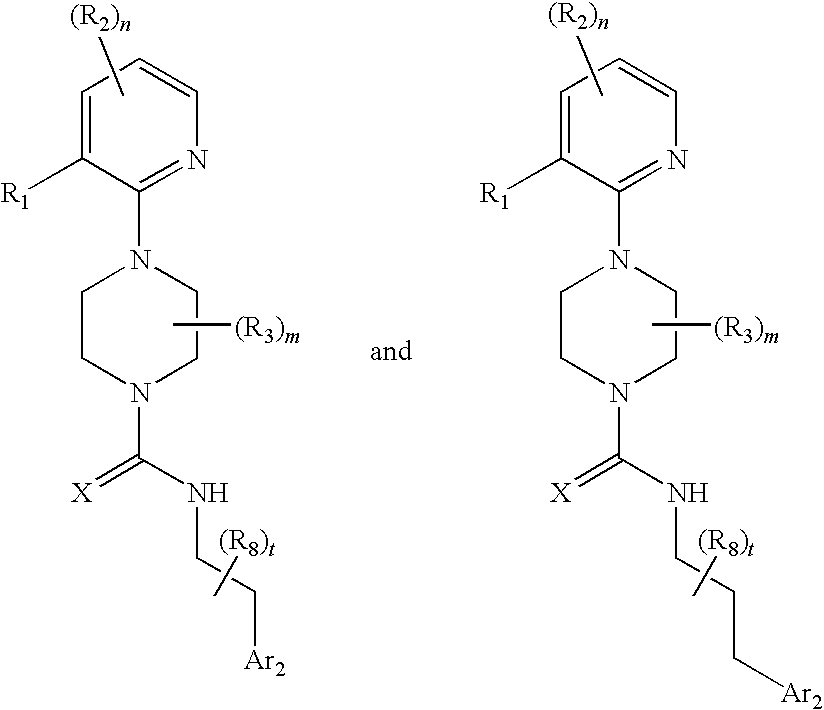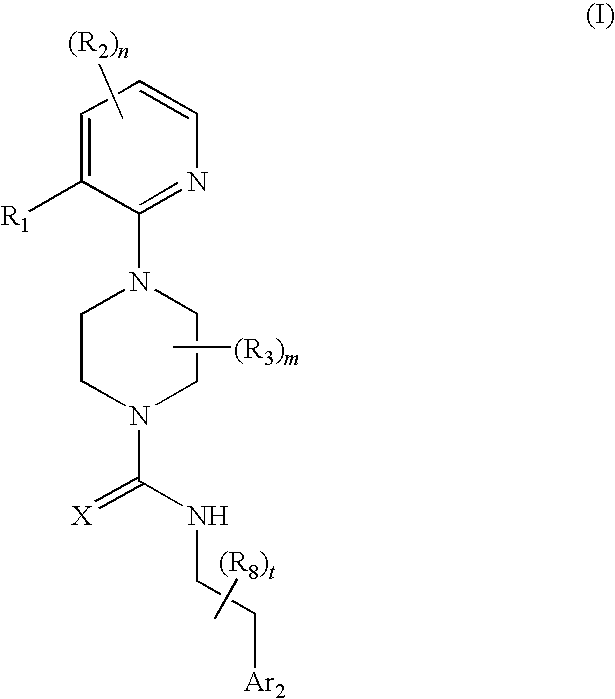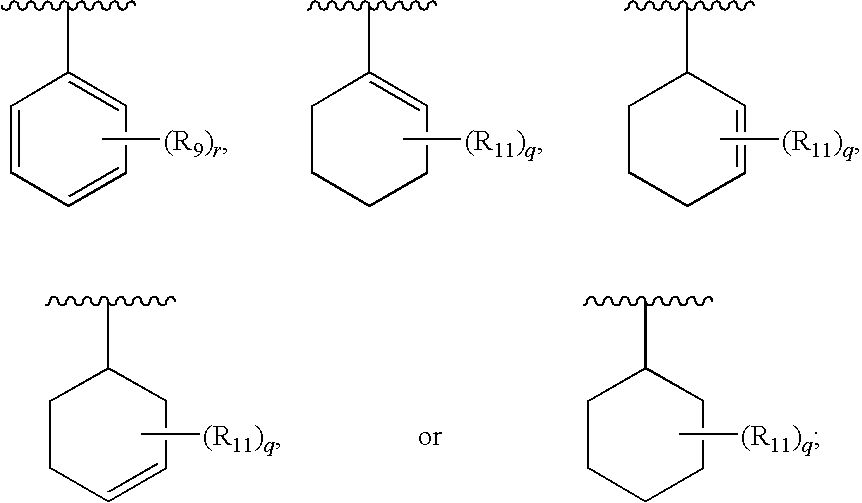Therapeutic agents useful for treating pain
a technology of pyridoxine and therapeutic agents, which is applied in the field of 3 substituted pyridoxine compounds, can solve the problems of ineffective drugs, no existing commercial drug treatment for ui patients has achieved complete success in all classes of ui patients, and treatment has not been significant adversely affected
- Summary
- Abstract
- Description
- Claims
- Application Information
AI Technical Summary
Benefits of technology
Problems solved by technology
Method used
Image
Examples
example 1
5.1 Example 1
Synthesis of Compound A19
[0365]
[0366]To a solution of 0.1 g (0.43 mmol) of compound 1 (commercially available from Maybridge Chemical Company Ltd., UK) in DCM (5 mL) was added 0.063 g (0.43 mmol) of phenethylisocyanate 2 (commercially available from Sigma-Aldrich, St. Louis, Mo. (www.sigma-aldrich.com)) and the resulting reaction mixture was stirred for about 4 h. at about 25° C. The solvent was removed under reduced pressure to provide a residue that was purified using a silica gel column eluted with a gradient of 20:80 ethyl acetate:hexane to 50:50 ethyl acetate:hexane to provide 3-substituted Pyridyl Compound A19 as a white solid (140 mg, 86% yield).
[0367]The identity of Compound A19 was confirmed using 1H-NMR spectroscopy and mass spectrometry (MS).
[0368]Compound A19: 1H-NMR (400 MHz, CD3OD): δ 2.85 (t, 2H), 3.32 (bm, 4H), 3.52-3.65 (m, 6H), 4.55 (bs, 1H), 7.05 (t, 1H), 7.21 (bm, 3H), 7.63 (t, 2H), 7.93 (t, 1H), 8.49 (d, 1H).
[0369]MS (EI): m / z 378 (m+1).
example 2
5.2 Example 2
Synthesis of Compound A57
[0370]
[0371]To a solution of 0.1 g (0.53 mmol) of compound 3 in DCM (5 mL) was added 0.078 g (0.53 mmol) of phenethylisocyanate 2 (commercially available from Sigma-Aldrich, St. Louis, Mo. (www.sigma-aldrich.com)) and the resulting reaction mixture was stirred for about 4 h. at about 25° C. The solvent was removed under reduced pressure to provide a residue that was purified using a silica gel column eluted with a gradient of 20:80 ethyl acetate:hexane to 50:50 ethyl acetate:hexane to provide 3-substituted Pyridyl Compound A57 as a white solid (150 mg, 84% yield).
[0372]Compound 3 was obtained by dissolving 5 g of 2-chloro-3-cyano-pyridine (commercially available from Sigma-Aldrich, St. Louis, Mo. (www.sigma-aldrich.com)), 6.21 g of piperazine (72.16 mmol) (commercially available from Sigma-Aldrich, St. Louis, Mo. (www.sigma-aldrich.com)), and 1.25 mL (72.16 mmol) of DIEA in DMF and allowing the resulting reaction mixture to stir for about 15 h. ...
example 3
5.3 Example 3
Synthesis of Compound A38
[0376]
[0377]To a solution of 0.1 g (0.48 mmol) of compound 4 in DCM (5 mL) was added 0.071 g (0.48 mmol) of phenethylisocyanate 2 (commercially available from Sigma-Aldrich, St. Louis, Mo. (www.sigma-aldrich.com)) and the resulting reaction mixture was stirred for about 4 h. at about 25° C. The solvent was removed under reduced pressure to provide a residue that was purified using a silica gel column eluted with a gradient of 20:80 ethyl acetate:hexane to 50:50 ethyl acetate:hexane to provide 3-substituted Pyridyl Compound A38 as a white solid (145 mg, 85% yield).
[0378]Compound 4 was obtained by dissolving 5 g of 2-chloro-3-nitro-pyridine (commercially available from Sigma-Aldrich, St. Louis, Mo. (www.sigma-aldrich.com)), 8 g of piperazine (94.5 mmol) (commercially available from Sigma-Aldrich, St. Louis, Mo. (www.sigma-aldrich.com)), and 12.21 mL (94.5 mmol) of DIEA in DMF and allowing the resulting reaction mixture to stir for about 15 h. Wate...
PUM
| Property | Measurement | Unit |
|---|---|---|
| temperature | aaaaa | aaaaa |
| temperature | aaaaa | aaaaa |
| temperature | aaaaa | aaaaa |
Abstract
Description
Claims
Application Information
 Login to View More
Login to View More - R&D
- Intellectual Property
- Life Sciences
- Materials
- Tech Scout
- Unparalleled Data Quality
- Higher Quality Content
- 60% Fewer Hallucinations
Browse by: Latest US Patents, China's latest patents, Technical Efficacy Thesaurus, Application Domain, Technology Topic, Popular Technical Reports.
© 2025 PatSnap. All rights reserved.Legal|Privacy policy|Modern Slavery Act Transparency Statement|Sitemap|About US| Contact US: help@patsnap.com



